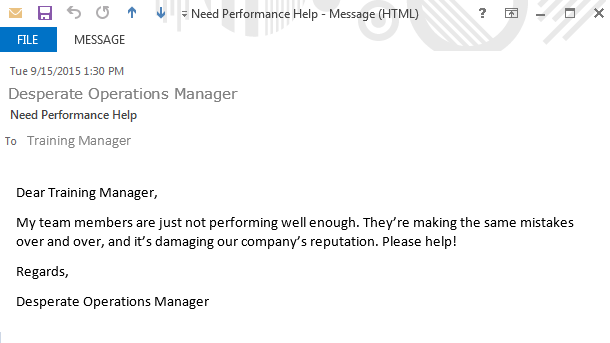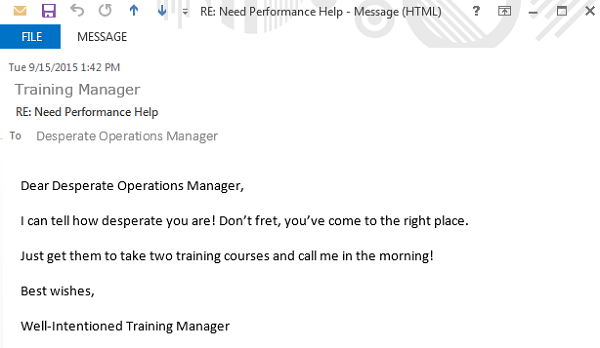Posted by Caveo Learning ● October 1, 2015
Getting the Business on the Performance Improvement Bandwagon
 Many learning leaders and organizations use the word performance so broadly, so easily, and so frequently, yet with very little intention or follow-through.
Many learning leaders and organizations use the word performance so broadly, so easily, and so frequently, yet with very little intention or follow-through.
Despite its ubiquity in the learning & development space, when most people talk about performance, they're really talking about training. And even when learning leaders are actually talking about performance, for the most part it's in the context of performance management, not performance improvement—a focus on removing all barriers to performance. These well-intentioned people have one or maybe two tools in their learning toolbox to impact workplace performance, and that's just not enough. This is where Abraham Maslow's famous quote comes from: “If all you have is a hammer, everything starts looking like a nail.”
Let's consider the operations manager for a large company, who feels she's not getting the optimum performance from her workers. She sends a plea to the training manager for help:
 So far, so good... until the training manager responds:
So far, so good... until the training manager responds:

That's an exaggerated exchange, of course, but the fact is that training has become the aspirin of the learning & development world.
Lack of knowledge and skills is, in fact, commonly a contributing root cause of performance gaps, and if we only ever address gaps with training, we will indeed often see performance changes (hopefully positive ones). However, there are many other root causes of performance gaps, and it's critical to understand, isolate, and resolve those, as well.
There's More to Performance Improvement Than Training
Anyone who creates and implements a learning solution will probably have impacted performance in some way, but is that sufficient reason to stand on a soapbox and announce to the world that you are a performance improvement organization, a performance department, or a performance consultant?
Even with good intentions, the answer is no. In order to be able to profess with credibility that you are a performance improvement-focused company, division, or person, you truly need to take full performance systems and root causes views. Likewise, you must show an intention to not only improve knowledge and skills, but to also improve actual performance by identifying, understanding, and removing or mitigating all performance gap causes. You need to be constantly asking why a gap exists and how it can be permanently closed.
In general, the L&D function needs to do a better job of addressing the whole of performance, not just those aspects that can be fixed by training. (For a primer, check out this on-demand webinar: "Human Performance vs. Training: What You Need to Know.") But the department managers are complicit in this as well, and it's up to us as learning professionals to make sure they are helping us help them. To that point, here is a statement that should make L&D folks smile:
Managers are just as responsible for their workers' performance as L&D is.
There, I said it.
The fact that departmental managers have support organizations like HR and talent management is a bonus, not an excuse—managers need to take a stand, to push back and demand more from those support organizations, including vendors. Managers need to:
- Expect more from support organizations than simply providing the same solutions they always offer, especially if they tend to do so automatically and without actively diagnosing root causes.
- Ensure that the spectrum of contributing levels of performance have been considered when solutions are offered—that the solution is an integrated one that resolves or mitigates as many of the root causes as is practical, feasible, and affordable. It's OK to compromise the quality of the performance solution for good business reasons, as long as the compromise is clearly defined.
Managers need to be performance-vigilant.
At the end of the day, managers are the first responders when it comes to performance gap issues. They need to be more aware of potential performance barriers in their department and ensure they are doing everything possible to proactively remove them.
For instance, before a product launches, managers should make sure not only that the team is trained on the product and its benefits, but also that there is ample stock to sell, that commission models are in place, that policies and procedures are in place and updated for all eventualities, and that there is support for the team for the first few days after launch.
It's the manager's responsibility to call for help early in the process, identifying the performance gap as early as possible and calling on the learning function right away. The sooner we are all working on understanding the causes of the gaps, the sooner we create integrated performance solutions to resolve the issues.
Working with L&D, whether the internal organization or external learning partners, is a collaboration that will yield best results when a true partnership is fostered. Managers need to take more responsibility for performance and not expect L&D to be employee repair facilities. At the same time, managers need to expect more from the training team to ensure that solutions are integrated performance solutions that mitigate or remove identified barriers to performance and are inherently aligned to the organization's business goals.
Don’t "take two trainings and call me in the morning"... call me now. Let’s understand the performance and then work to solve it.
Topics: Performance Improvement
